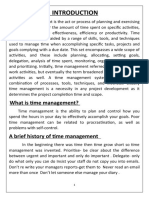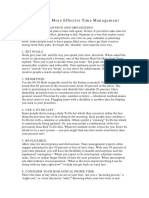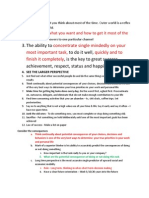0% found this document useful (0 votes)
12 views5 pagesTime Management
Time management is essential for personal improvement, but many popular techniques are too rigid and don't account for individual circumstances. The document outlines a flexible approach to time management, emphasizing the importance of observing daily routines, identifying time-wasting loopholes, and breaking unhelpful habits. It also provides practical techniques to maintain focus and prioritize important tasks effectively.
Uploaded by
Muhammad Shahbaz SaleemCopyright
© © All Rights Reserved
We take content rights seriously. If you suspect this is your content, claim it here.
Available Formats
Download as PDF, TXT or read online on Scribd
0% found this document useful (0 votes)
12 views5 pagesTime Management
Time management is essential for personal improvement, but many popular techniques are too rigid and don't account for individual circumstances. The document outlines a flexible approach to time management, emphasizing the importance of observing daily routines, identifying time-wasting loopholes, and breaking unhelpful habits. It also provides practical techniques to maintain focus and prioritize important tasks effectively.
Uploaded by
Muhammad Shahbaz SaleemCopyright
© © All Rights Reserved
We take content rights seriously. If you suspect this is your content, claim it here.
Available Formats
Download as PDF, TXT or read online on Scribd
/ 5
























































































